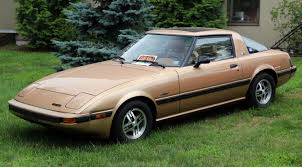-
Insurance
InsuranceAbout our productsLearn about insuringGet a quote Get current values, historical values, model history and more.
-
Valuation
ValuationHagerty valuation toolLook up a vehicle value Get current values, historical values, model history and more.
-
Events
EventsHagerty official eventsHagerty ClubhouseEvent calendar
-
Entertainment
EntertainmentMore to explore
- Portal login
1988 Mazda RX7
FC Coupe 1.3 L
Vehicle values by condition
Fair
Condition 4
£4,100
#4 cars are daily drivers, with flaws visible to the naked eye. The chrome might have pitting or scratches, the windshield might be chipped.
Good
Condition 3
£5,500
#3 cars could possess some, but not all of the issues of a #4 car, but they will be balanced by other factors such as a fresh paint job or a new, correct interior.
Excellent
Condition 2
£9,100
#2 cars could win a local or regional show. They can be former #1 cars that have been driven or have aged. Seasoned observers will have to look closely for flaws.
Concours
Condition 1
£12,000
#1 vehicles are the best in the world. The visual image is of the best car, unmodified, in the right colours, driving onto the lawn at the finest concours.
Insurance premium for a
1988 Mazda RX7 FC Coupe 1308
valued at £5,500
£203.37
/ year*
History of the 1986 - 1988 Mazda RX7

1986 - 1988 Mazda RX7
Mazda RX-7 FC (Coupe), 1985-1992
The Mazda RX-7 FC was in production from 1985 until 1992. Styled by Akio Uchiyama, it is a front-engine, rear wheel drive coupe seating two adults and two children.
Styled to resemble the Porsche 924 and 944, the second generation of RX-7 was the result of market research in America. Mazda studied the cars RX-7 owners had been considering, and the cars bought by potential customers, and concluded that a softened Porsche look would improve sales in North America. America had been the largest export market for the outgoing version, and this car was tailored to American tastes. That means it became softer – less a sports car and more a sports tourer. The original’s live axle at the back was replaced with independent suspension, and its recirculating ball steering with rack and pinion. A number of models were produced, ranging from the standard coupe to a convertible, and even a Turbo which by the end of production would be producing 200bhp. All Japanese RX-7s are turbocharged – find a naturally aspirated RHD car and the likelihood is that it’s an original UK car – a choice Mazda made as the Western insurance industry had begun to penalise turbocharged cars.
It might be softer, but even the naturally aspirated variant is quicker than its predecessor – not surprising when the outgoing model had 115bhp and the new car 148. Unfortunately, its extra weight counts against it from a standing start – it’s barely faster to 60 than the old car, though a slippery shape means top end and in gear acceleration are improved. The passive rear wheel steering helps with overall surefootedness in the corners, though the suspension is perhaps firmer than some of its closest rivals – tuned for the UK as a sports car, it doesn’t quite feel right when linked to such a smooth engine and excellent gearing for long distance touring. A shade confused about itself then, but by no means a bad – or dull – car.
Floors and sills can rust, so check these thoroughly as well as checking all the panel gaps for signs of potential accident damage. Rust behind the taillights can cause leaks into the boot, so check as thoroughly as you can for this and ask questions if the boot carpet is damp. Drivers’ door locks can fail, as can window switches. Most important though is the rotary engine - oil pressure sender leaks are common, so check for evidence by the oil filter. Check for compression if possible – you’re looking for 85psi or better, when cold and when warm. Flooding fuel injectors can lead to difficult hot starting, a pain to fix but possible. Smoke upon startup is normal provided it dissipates after a couple of seconds, it’s a quirk of rotary engine design. Check the oil seals by holding it at 6000rpm for 30 seconds and then letting the throttle up abruptly. Smoke from the exhaust means the oil seals are on their way out, and that’s engine rebuild time.
Turbocharged models are the most desirable and thus the most valuable, followed by the convertibles. Choose a strong colour, and buy a car in the best possible condition with as much service history as possible – with something specialist such as a rotary engine, service history can be vital. Ideally, speak to the specialists who’ve looked after the car for an independent idea of its condition.
An example of the preceding FB RX-7 or the later FD might appeal, if you want a sportscar with a rotary engine – perhaps even an RX-8. If you’re after period competition it doesn’t get better than the Porsche 944, though you might also want to consider a Toyota Supra or a Nissan Silvia Turbo. If you want something truly left field, consider an Isuzu Piazza Turbo.
Hagerty Newsletter
Get your weekly dose of car news from Hagerty UK in your inbox

ADVERTISEMENT